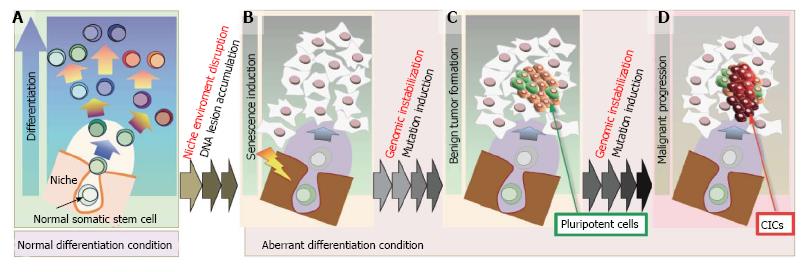Copyright
©The Author(s) 2015.
World J Stem Cells. Mar 26, 2015; 7(2): 483-489
Published online Mar 26, 2015. doi: 10.4252/wjsc.v7.i2.483
Published online Mar 26, 2015. doi: 10.4252/wjsc.v7.i2.483
Figure 1 Model of cellular immortalization in association with genomic instability.
As illustrated in mouse embryonic fibroblasts, immortality is induced by genomic instability and mutation of either Arf or p53. Growth arrest and the downregulation of H2AX protect mouse embryonic fibroblasts against immortalization. Because H2AX downregulation is dependent on the ARF/p53 module, cells with mutations in this module recover H2AX expression and growth activity. CIN: Chromosomal instability; MSI: Microsatellite instability.
Figure 2 Model of cancer-initiating cell development.
A: In normal tissues, stem cells are maintained in a specific niche and the niche environment is important both for stem cell maintenance and organ homeostasis; B: Niche disruption deranges the differentiation environment of stem cells, leading to the accumulation of DNA lesions and the induction of cellular senescence. Such DNA lesions trigger genomic destabilization, leading to the development of benign tumors that contain a small number of C: Pluripotent cells that eventually develop into; D: Cancer-initiating cells (CICs) that cause malignancies.
- Citation: Yoshioka KI, Atsumi Y, Nakagama H, Teraoka H. Development of cancer-initiating cells and immortalized cells with genomic instability. World J Stem Cells 2015; 7(2): 483-489
- URL: https://www.wjgnet.com/1948-0210/full/v7/i2/483.htm
- DOI: https://dx.doi.org/10.4252/wjsc.v7.i2.483














